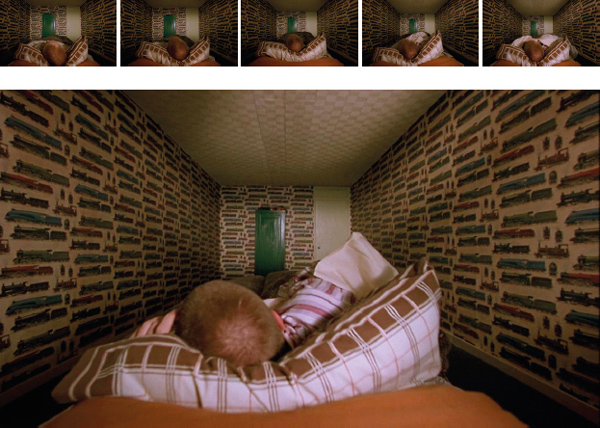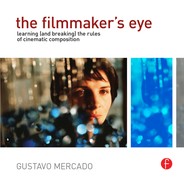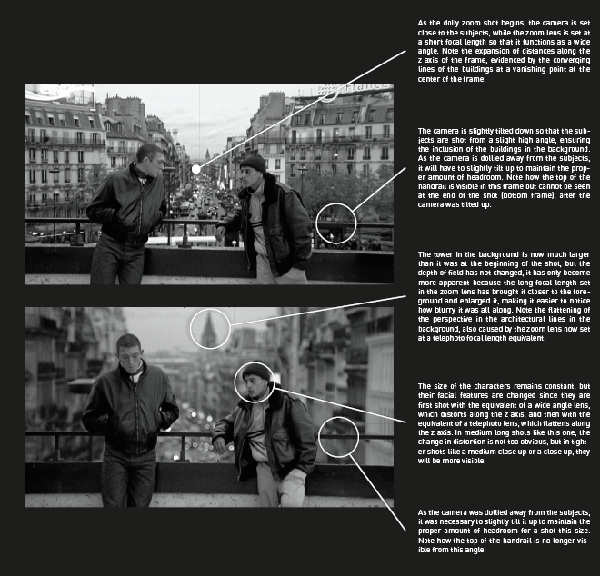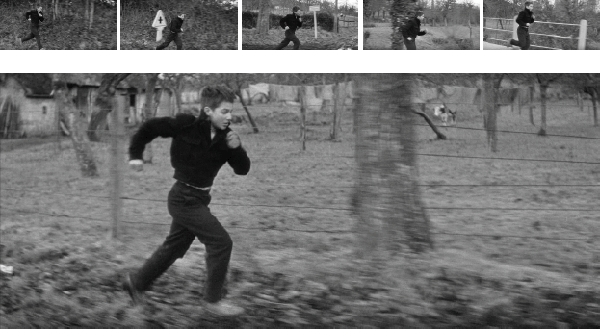dolly zoom shot
Also known as a “counter zoom,” “contra zoom,” “trombone shot,” “zolly,” and perhaps most famously, the “Vertigo effect” shot, the dolly zoom was introduced to the mainstream cinematic vocabulary in Alfred Hitchcock’s Vertigo (1958), to visualize the fear of heights experienced by detective John Ferguson (James Stewart) at key moments in the story. The shot is created by using a combination of a dolly shot with a zoom shot, working in tandem so that as the camera dollies in toward a subject, the lens is zoomed out, or zoomed in if the camera dollies out. The resulting shot, when executed properly, keeps the subject’s size constant in the frame while the background perspective changes drastically, appearing to get closer or further away. The effect is extremely overt and unsettling, and is therefore reserved for moments in a story when something especially meaningful is taking place. A very common use of the dolly zoom shot is in situations where a character has a sudden realization, or is surprised by something they see or learn. Other uses include visualizing extreme emotional states, like rage, obsession, falling in love, paranoia, fear, and even drug-induced states. The speed at which the dolly zoom shot is executed can affect the way it is interpreted by the audience and the emotions it can convey. To convey extreme emotions, the dolly zoom is usually performed quickly, making the change in perspective in the background extremely noticeable. In other cases, the dolly zoom is performed very slowly, making the shift in perspective subtle and at times difficult to see; the effect is not as unsettling, conveying that something meaningful, although not necessarily extreme in nature, is taking place. A less common use of the dolly zoom is to showcase the background of the composition instead of a subject in the foreground, who is kept out of focus; in this case the dolly zoom visualizes a character’s warped perception of their surroundings, normally due to their state of mind or supernatural influences (a favorite visual trope in Horror films).
The example on the opposite page, from D.J. Caruso’s Taking Lives (2004), shows the most common use of the dolly zoom shot, as an FBI profiler (Angelina Jolie) helping to catch a serial killer suddenly discovers that a witness she became intimate with is in fact responsible for the murders. The dolly zoom used here starts with the zoom lens set as a wide angle and a short camera to subject distance. As the shot progresses, the camera is quickly dollied away while the zoom lens is adjusted into its telephoto range, keeping the subject size constant while the background appears to get closer to her (note how much less of the walls in the hallway can be seen in the last frame than in the first frame). The dolly zoom effectively conveys the surprise, disorientation, and shock felt by the character at this critical moment. This shot also demonstrates that when the size of the subject is kept constant, a change in focal length does not affect the depth of field when counterbalanced by a shift in camera to subject distance, as seen in the background, which remains consistently out of focus whether the zoom lens is set to a wide angle (at the beginning of the shot) or a telephoto setting (at the end).
A classic use of the dolly zoom shot is to underline a character’s sudden realization that something is wrong, as seen in this example from D.J. Caruso’s Taking Lives (2004).
dolly zoom shot

why it works
The unusual change in perspective produced by a dolly zoom can visualize a meaningful moment or situation, indicating to the audience that something out of the ordinary is taking place. In this example from Mathieu Kassovitz’ La Haine (1995), a dolly zoom shot is used to convey how a group of friends raised in the “banlieues” (impoverished French housing projects) feel when they arrive in Paris to collect a debt. Although Vinz (Vincent Cassel, left) and Saïd (Saïd Taghmaoui, right) appear to be indifferent to their surroundings, the dolly zoom reveals how uncomfortable they are when they find themselves outside of their marginalized neighborhood.
technical considerations
lenses
The zoom ratio of the zoom lens you use can determine how drastic the change in perspective in the background will be, and will also affect how much the camera will need to be moved towards or away from subjects to keep them at a constant size in the frame. For instance, the zoom ratio of the lens used in the example on the first page of this chapter, from Taking Lives, is not as high as the zoom ratio of the lens used in the example from La Haine on the previous page, as seen by the different levels of magnification in their respective backgrounds. A zoom with a high zoom ratio will also make it more challenging to maintain the subjects in focus as the camera is moved, necessitating precise measurements to determine the exact camera to subject distance at both ends of the shot. It is also important to determine the amount of distortion that is acceptable to have on the subject, since at both ends of the dolly zoom you will have wide angle warping or telephoto flattening of facial features. While this might not be too noticeable in a medium long or medium shot, it might be an issue in medium close ups and close ups.
equipment
As with a moving camera zoom shot, a focus puller will be necessary for a dolly zoom shot, since the camera to subject distance does not remain constant. A follow focus attachment will simplify matters tremendously, especially since the focal length ring will also have to be accessed during the shot by the camera operator. The camera can be moved with a dolly, on tracks, with a Steadicam rig, and even handheld, but keep in mind that it will be more difficult to execute the shot properly with a Steadicam or a handheld camera than it will be with a dolly, because of the challenges to choreographing the independent movements of three people (camera operator, focus puller and spotter) instead of having them all standing on board a moving dolly. An alternative is to use a wireless system to pull focus remotely while the camera operator manipulates the zoom ring as he or she walks with the camera, but it will still require a lot of practice to do it properly. Regardless of how the camera is moved, it is absolutely essential that the speed at which it moves closer to or away from a subject matches the speed at which the zoom ring is manipulated; otherwise, the subject will seem to grow larger or smaller while the background moves closer or farther away, undoing the effect of a dolly zoom. You will need to do more than a few practice runs to get it right, since you have to coordinate the efforts of the grips moving the dolly, the camera operator manipulating the zoom ring, and the focus puller.
lighting
Since the size of the subject must remain constant in a dolly zoom shot, depth of field will mostly be a function of the aperture setting. Camera to subject distance will of course also affect depth of field, but in most instances the dolly zoom shot will not allow you to have the camera sufficiently far away from the subject to throw the background in focus, so its effect in the depth of field will be minimal. The disorienting effect of the dolly zoom can still be produced whether you choose to have a shallow or a deep depth of field (since it is more a function of the zoom ratio of the lens), so your selection can be based on your need to have the background, the foreground, or everything in focus, depending on the needs of your story.
breaking the rules

This shot, from Danny Boyle’s Trainspotting (1996), has all the telltale signs of a dolly zoom shot: subject size remains constant, and the background appears to recede into the distance. However, it is not a dolly zoom at all; the bed was simply rolled back along with the camera inside a specially built set. The resulting effect is even more unsettling than in a normal dolly zoom, adding a surreal touch to the depiction of the withdrawal pangs suffered by Renton (Ewan McGregor), a heroin addict on the mend.
The 400 Blows. François Truffaut, 1959.


